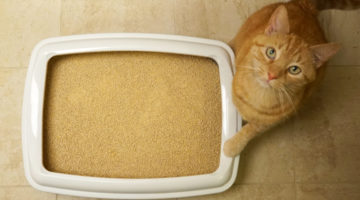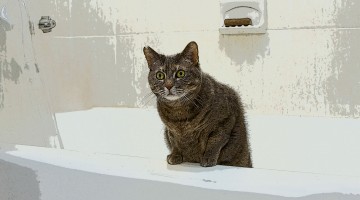The “other” litterbox problem – causes and solutions.
Urinating outside the litterbox is a fairly common issue in cats, so it gets the most attention. We don’t hear as much about cats that defecate outside the box, yet it does happen. In order to solve the problem (called “middening”, according to the American Association of Feline Practitioners), we first need to understand that defecating outside the litterbox doesn’t have the same causes as inappropriate urination.
Medical causes
The first step when your cat avoids the litterbox for bowel movements is to rule out medical problems with a trip to the vet.
- Not surprisingly, digestive issues are a major cause of soiling outside the litterbox. Both constipation and diarrhea can be culprits.
a) When Beth Heidi Adelman’s cat, Spike, started avoiding the litterbox, he was diagnosed with chronic constipation due to an anatomical defect. Working with her vet, Beth solved the problem by giving Spike a diet of wet food, plus a high fiber food placed in his toys overnight.
b) In contrast, the cat may be experiencing diarrhea. “Felines with various forms of bowel disease in which there is painful gas, a burning anus or chronic diarrhea, can form negative associations with the litterbox,” says Dr. Kneebone.
Chronic constipation or diarrhea can have many causes, ranging from IBD to food allergies to cancer, so it’s vital to have these issues assessed and treated by a vet. - Dr. Kneebone adds that arthritis of the hips, knees or back can make it painful for an older cat to get into a high-sided litterbox. A clue that this could be the problem is when a cat leaves feces beside the box rather than in it. Start by trying a litterbox with lower sides and talk to an integrative or holistic vet about supplements and therapies that can ease her discomfort.
- “The elderly cat may have dementia and forget how to use the box, or where it is,” says Dr. Kneebone. Again, integrative therapies can help a cat with cognitive dysfunction, so talk to your vet.
Behavioral causes
Once medical problems have been ruled out, you can start looking at behavioral causes. These can include the following:
- Dr. Kneebone says that if a cat is startled while in the act of doing his business, especially if it happens more than once, the negative experience may be reason enough for him to start avoiding the litterbox.
- If a cat is ambushed by another household cat while using the litterbox, he may seek out a quieter area in which to do the contemplative part of his business. Hence the need for litterboxes in more than one location.
- The litterbox itself may be the problem. Read on.
Positions for elimination
Cats use different positions when defecating versus urinating. When peeing, a cat squats, although there is the occasional vertical “pee-er”. It’s a pretty quick process, assuming all is normal.
At first glance, the position for defecating looks similar, but in reality, the squatting position is slightly raised and the abdomen swells out. The process also takes a bit more time, effort and concentration than does urination.
Litterbox recommendations
Veterinarians and behavior consultants alike recommend a litterbox overhaul as part of the treatment plan for inappropriate defecation.
As a certified cat behavior consultant, Beth always checks out a cat’s litterbox when meeting with clients. “At least half the time the box is too small, and the cat’s butt is hanging over the edge,” she says. She describes this situation as “accidently outside the box”, adding that sometimes feces will stick to the cat’s bottom and land elsewhere. The same “accident” can happen if a cat makes that mad dash when exiting the box, bringing along a few feces that haven’t been completely eliminated. “Some cats may also be diggers, so feces are thrown out of the box,” Beth says.
“Some cats may also be diggers, so feces are thrown out of the box.”
To help solve these issues, Beth recommends a big open litterbox (especially if feces are found near the box), with extra litterboxes throughout the house.
“Use a litter that will feel soft,” she adds. She says she sometimes rolls up her sleeve and presses her forearm into a clean litterbox. “If the litter hurts you, it hurts the cat,” she says. Cats must feel comfortable digging in their litter if they’re going to use it. “They need something soft and grainy, that smells like nothing.” (Editor’s note: for more on litter choices, see “The latest in cat litter”, AW V19I2).
Karen London, who has a PhD in animal behavior, recommends placing the litterbox in an open area that’s clear of anything that might be disturbing or distracting. “Cats don’t like to be surprised,” she says. Dr. Kneebone concurs: “If the box is in the basement, don’t put it by the laundry machines or the furnace.”
Finally, always remember that good litterbox housekeeping is a must. The box should be scooped daily to keep it clean and odor-free. “If you can smell it,” says Beth, “your cat smelled it a week ago.”






No Comment